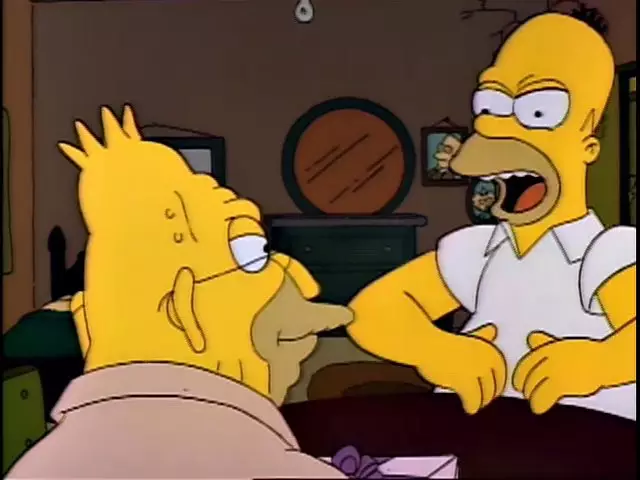My Recollection
The Munroe Box. Frink. Grampa gambling. DISCOUNT LION SAFARI!
It was around year 10. I looked like Martin Prince and sounded like Martin Prince doing a David Spade impression. My friend looked like a bootleg Chucky doll and sounded like Ren Hoëk on helium. We were friends because of a shared interest in weed and because nobody else would be. Where we are, at this point in the narrative, is very high in front of a tiger.
The thing about zoos in Australia is that, for a long time, they were mostly for tourists. I don’t need to go to a place to see kangaroos, those buggers still get about the suburbs, it’s like going to a prison to see people. The big southern zoos had things like lions and elephants, but Brisbane is neither big nor as southern so all the zoos here were mostly weird little things filled with the kinds of harmless marsupial rat-midgets I could otherwise see outside.
The only time you saw anything that wasn’t a bite-sized puff-ball desperately trying to not go extinct was when Dreamworld finally got a bunch of lions. Dreamworld isn’t a zoo, it’s the one decent theme park Australia has that isn’t water or movie based. The theme parks all live together in a cluster on the Gold Coast and it’s where we went for end of school excursions and such. Then they got a bunch of tigers because I suppose you just don’t turn down tigers.
I like cats, so I assumed that being really high with a tiger would give me the ability to form an inseparable bond with it so we could travel the country solving mysteries. This one was a bit stand-off-ish. Can tigers tell if you’re high? This one is looking at me funny. I didn’t think there were sniffer tigers. Its teeth are the kind of thing that could hurt you even if it isn’t trying. It’s not purring. Maybe it hates me or maybe the big ones don’t purr. The fluff is thick. I’m scared now.
We decided that “teens on drugs rubbing tigers” was the start to an hilarious tragedy we didn’t want to be a part of, so we made for the machines that whirl you through the sky. We settled on the Wipeout, a ride that simulated surfing by mimicking the movements of someone fencing with a baguette.
The whole point of a ride is safe terror. I’m acrophobic and still go on things like The Giant Drop, even though I fucking hate The Giant Drop, because it stimulates areas of my brain my wall and roof-based existence doesn’t. The idea is to cling to the knowledge that you’re sitting in several millions of dollars’ worth of tech, engineered to be mostly idiot proof, while your animal brain shrieks at you. But you need both for it to work. Anything not scary is dull, and anything whose safety is predicated on a small chain and carny wink becomes actual danger.
Speaking of actual danger, the Wipeout was broken that day and we found that out the hard way.
The seats have the standard over-the-shoulder style lock that keeps you from flying away and this is then reassuringly assisted by a bar that comes up between your legs and locks that first one even further in place. Two locks! Safe! Mine comes down and clamps in with a reassuring robot squeeze. My friend’s comes down, clamps, rethinks this, and then unclamps a bit before the under-pole comes up and does it’s job.
He’s trying to tell me his thing is broken and I’m telling him it’s fine, it’s a big machine designed for this, it’s fine. The baguette has two sides with a row of seats on each and you get to these via these little bridges that fold back when the ride kicks off. As the little bridges start folding back, taking any chance of rescue with them, the chest lock, the one that keeps you from being flung god knows where, starts with its bullshit again.
CrrrrrRRRRRRRRRRRRRRR-THUNK-THUNK-THUNK-THUNK-THUNK
Each thunk is the chest lock trying to quit its job and getting stopped at the door by the under-pole. It’s hitting the under-pole and loosening its grip on my friend at the same time.
He goes mental, but because he sounds like a balloon being emptied through a kazoo, and because the ride is now, technically, in action, everyone just thinks he’s a huge pussy.
I’m laughing my fucking arse off. I have faith in the under-pole, and the systems that design and build these things. I don’t think he’s in any serious trouble, but, as far as he’s concerned, he’s at Cackling Carny level of real danger. The ride goes for a few minutes. It’s not a short ride. There’s upside down parts. This surfing influenced baguette riposte is designed to give you your money’s worth.
THUNK-THUNK-THUNK-THUNK
AIIIIIIEEEEEEEEEEEEEEEEEEEEEEEEEEEEEEEEEEE!
HAHAHAHAHAHAHAHAHAHAHAHAHAHAHAHA!
¡∀H∀H∀H∀H∀H∀H∀H∀H∀H∀H∀H∀H∀H∀H∀H∀H
¡ƎƎƎƎƎƎƎƎƎƎƎƎƎƎƎƎƎƎƎƎƎƎƎƎƎƎƎƎƎƎƎƎƎƎƎIIIIII∀
ʞN∩H┴-ʞN∩H┴-ʞN∩H┴-ʞN∩H┴
I made fun of him, even after they put an out of order sign on the seat he’d used, but that was before a few people got mashed up in the White-Water Raft’s gear system, so I suppose he had the last laugh.
The Episode
There’s always a notch of artificiality to any work if for no other reason than cameras don’t film, edit, and broadcast material at random. This means that anything you see will have some degree of intent behind it and this intent will frame construction and reception. The varieties of forms these take create a taxonomy which, like the one of the natural world, has forms and families of forms that are closer together than they are to others. Documentaries and Marvel movies are on fairly separate branches, for instance, due to very different initial goals.
Within narrative filmmaking, one is generally seeing either formalist, realist, or, the fusion of the two, classical. Realism is like prose, it eschews much of the noticeable techniques of film –fancy shots, non-diegetic music, metaphor– to focus on delivering narrative in a manner that mimics the natural world. Formalism is more akin to poetry and will heavily lean into the language of film to tell or influence the narrative. Little cinema is at either end, most of what we watch would be classified as classical: a blend of the two. In spite of this common fusion, there are still structural elements of each side that can clash awkwardly when put together poorly.
Most movies are of a formalist narrative structure as the neatness of the beginning-middle-end process, and any number of other tropes within, are wildly unnatural. Exceptions are rare, and unpopular, because a finite experience like a movie isn’t really allowed to dabble in the unfair cosmic randomness of reality without chafing the viewer. The world is a place where Chekhov’s gun may never be fired.
Take The Last Jedi as a good example of this clash. The Star Wars universe, as a space opera about the hero’s journey, is openly formalist. Scenes like an exploding planet creating a fissure that conveniently separates two duelling characters would, within realism, be an absurd coincidence. But here they’re a clear visual metaphor in a film series full of them. Couple this with being more a high fantasy engine in a sci-fi chassis, and you have something quite unrealistic.
By comparison, the narrative structure of Rose and Finn’s mission to find a codebreaker on Canto Bight is realist, and bizarrely so when compared to its surroundings. They don’t find the codebreaker they are looking for, they pick up a random fellow who says he can do it, they take said to the ship to save the day, get caught, and then finally betrayed by the random fellow which thwarts their whole mission. It’s just a series of occurrences. There’s no moral, no dangled gun that gets fired, and no poetic metaphor which would all be fine except it sits within a film, series, and genre defined by them.
Old Money is a similarly peculiar piece. In medias res can function as a standard, if dynamic, form of opening, but beginning a story at the conclusion of an event, Grampa’s trip to the liquor store, impresses on the viewer that these lives exist outside the show’s formal confines. An odd tone to set for an animated series but one continued with the story’s act structure.
Most Simpsons episodes have a small narrative preamble of about two or so minutes before pivoting to the proper story (the good ones, like Bart’s Dog gets an F, often skip that step). This is because the story pivot largely dumps what has occurred prior and this wastes valuable space. Old Money dumps us into a continuing plot concept before pivoting to Grampa’s relationship with Bea, which would normally carry the rest of the plot, then pivots again to Bea’s death, and finally Grampa figuring out what to do with the money. Amidst this is a kind of vestigial B plot of Homer and Grampa’s relationship, but this lasts for 3 actual minutes of screen time. Like a penis, a tiny, functionless one is worse than none at all, and this plot strand is little more than a way to drag Homer in as a function for the final scenes.
This has the potential to actually work. Abraham, first named here, is seldom treated like a serious character and when he is, he’s typically a foil for one of the other family members. So, it’s a treat to see a real character under the old-man jokes, and the focus gives his story the respect a family member’s perspective on it wouldn’t. This is a story about what it’s like to be old from an old man’s view, and a realist plot structure fits that like a glove. Your family barely cares. Your living situation is grim. And omnipresent death can reach out and take what little happiness you manage to find. Formalist pap would cheapen this and that’s ultimately where the episode falls down. Like with Last Jedi, the formalist and realist elements aren’t mixed into classical, but awkwardly placed side by side where each spoils the other. Had this realism run through the whole episode, it would have stood as an unusual but otherwise great episode. But it’s a sitcom and they chicken out with a hacky trope ending and a mishmash of poorly organised conflicts.
There’re a few conflicts at work and that suits a realist approach as life is sadly lacking in convenient nemeses, but with the formalist ending it would have been better to have picked one. The overarching one of Grampa and the indignity of old age is a good choice for undercoat. It’s the kind of thing that can connect broader ideas and themes while being wrapped up well into a largely satisfying conclusion of a renovated Springfield Castle. But the conflict that takes centre stage is split for no earthly reason. Grampa ripping his shirt and declaring he has no son is a very real moment, and the subsequent emotional damage to Homer is harrowing. There’s effort put into this, including a beautiful shot of Homer crying in the lounge room, but it’s resolved in three minutes after Grampa’s rollercoaster epiphany. This would be fine had they not then recycled elements of the father/son conflict for Homer stopping Grampa from gambling. There was no reason to resolve the emotional tension between the pair before that scene and the result is neither formalist nor realist but just bad.

Ultimately, Old Money is several good ideas for several different things, hamstrung by some bad choices. It’s a shame as the Simpsons formula starts to kick-in in earnest soon and these odd episodes pretty much vanish.
Yours in starting over from your beginnings, Gabriel.
Jokes, lines, and stray thoughts.
Jasper laughs when Abe gets the wrong medicine and this simple little cruelty really makes me chuckle.
Bea’s death is so cruel they had to give her the rollercoaster scene to counter it.
Speaking of, it’s a good example of how something within a closed narrative environment feels like a cheat if it’s not set up. Had there been so much as a mention of her having heart troubles in the story, it creates a closed loop of expectation and removes the unfair random feeling.
GRANDMA’S WORLD!

Much of The Simpsons’ old-person jokes are fundamentally cruel and lean on their presentation of jokes to create an absurdity, but Homer teasing and abducting Abe is reeeeeeal harsh.
The episode has a few great shots in it, either through creative framing or just fun. I’ve mentioned the lounge shot but this one of Bart staring at the lion also stands out.

If you hate someone, make them carry a coffin. They are heavy as shit and the handles are garbage. Literally cut into your hand.
Grampa screaming up the rollercoaster is a great gag and a solid visual

This episode marks the first appearance of Professor Frink! First named for one of the writer’s friends who went on to write for the show as well.
There’s little in the way of classic jokes in the episode as it’s mostly focused on expressing its narrative, so the gags are all compiled into the scene where Grampa selects a worthy recipient. The scene sits awkwardly in the episode and goes too long, it blocks up the emotional arc between Homer and Abe, but it is funny. Moe’s dumb plan being frontrunner, and the Monroe Box are good.
“Mellow out, old dudes, or I’ll jam this baby into a river!” is a great Otto line.
There’s a kind of odd joke at the end where Grampa is placing his bet and the “I’ve got a feeling about that number” moment is repeated. It’s one of those odd little ones that mostly only animation can get away with. Being totally identical adds a touch more to the idea that he’s saying it about different numbers.





3 replies to Old Money
Magnumweight on 2nd March 201902 Mar 19 said:
One of the things I remember most about this episode, besides the Munroe Box and Bea's death, is the scene where Abe and Bea seductively eat their pills. I remember the scene mostly because as a child I tried to take my pills in a similar manner once, then realizing these things aren't made to chew, breakfast was not fun that day
Gabriel on 17th March 201917 Mar 19 said:
I actually forgot to bring that scene up, it was in my notes and everything. I love it, there're some great gifs in there and seductive Grampa is always a shudder-inducing treat.
Bungus Bronbo on 16th March 201916 Mar 19 said:
Aw shit, I was waiting for this episode to be reviewed, and you did not disappoint.
Comment on Old Money
To reply, please Log in